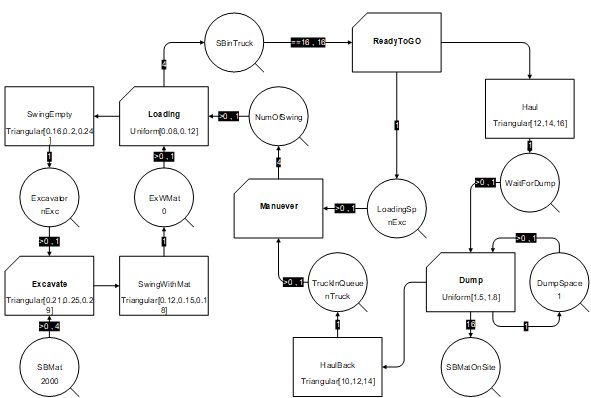การประเมินค่าฝุ่นละอองจากเครื่องจักรหนักงานก่อสร้างและแนวทางการบรรเทาผลกระทบเพื่อพัฒนาสิ่งแวดล้อมอย่างยั่งยืน กรณีศึกษาโครงการก่อสร้าง ชั้นทางแบบผิวทางยืดหยุ่น | Evaluating Particulate Matters from Heavy Construction Equipment and Mitigation Strategies for Sustainable Environment: Case Study of Flexible Pavement Projects
Main Article Content
Abstract
Nowadays, an increase of the particulate matter (PM) impacts human health and life, especially in the construction industry, and road construction projects utilized with heavy equipment with a high fuel consumption rate that directly generates PM and pollution. This research, therefore, aimed to develop the PM evaluation model due to the equipment operations and to propose construction equipment allocation and management strategies for mitigating the environmental impact. Four different sustainable mitigation options were used: 1) biodiesel usage; 2) new equipment replacement; 3) hybrid engine replacement; and 4) retrofit device installation. The results presented that the amount of PM emission from the equipment operations in the project case study was 27.48 kg. In addition, the emission was reduced by approximately 10% when applying the biodiesel option. Moreover, selecting the proper hybrid and retrofit options could enable a complete and efficient PM reduction.
บทคัดย่อ
ปัจจุบันปริมาณฝุ่นละอองที่เพิ่มสูงขึ้นส่งผลกระทบต่อสุขภาพและการดำรงชีวิตของมนุษย์ โดยเฉพาะอุตสาหกรรมก่อสร้าง เช่น โครงการก่อสร้างประเภทงานทาง มีการใช้เครื่องจักรหนักซึ่งมีอัตราการบริโภคน้ำมันเชื้อเพลิงสูงก่อให้เกิดมลภาวะอากาศและฝุ่นละอองโดยตรง งานวิจัยนี้จึงมีวัตถุประสงค์เพื่อพัฒนาวิธีการประเมินค่าฝุ่นละอองและเสนอแนวทางการจัดสรรทรัพยากรเครื่องจักรเพื่อลดผลกระทบสิ่งแวดล้อม ซึ่งจากการจัดสรรทรัพยากรเครื่องจักรร่วมกับการประยุกต์ใช้แนวทางการบรรเทาผลกระทบด้านสิ่งแวดล้อม 4 แนวทาง คือ (1) การเลือกใช้น้ำมันไบโอดีเซล (2) การเลือกใช้เครื่องจักรรุ่นใหม่ (3) การเลือกใช้เครื่องจักรประเภทไฮบริด และ (4) การเลือกติดตั้งอุปกรณ์กรองมลพิษไอเสีย ผลการวิจัยพบว่าการใช้ทรัพยากรเครื่องจักรในการก่อสร้างโครงการกรณีศึกษาก่อให้เกิดฝุ่นละออง เท่ากับ 27.48 กิโลกรัม ทั้งนี้หากมีการประยุกต์ใช้แนวทางการบรรเทาผลกระทบด้านสิ่งแวดล้อมโดยการเลือกใช้น้ำมันไบโอดีเซลส่งผลให้ค่าฝุ่นละอองลดลงประมาณ 10% ในขณะที่การเลือกใช้เครื่องจักรรุ่นใหม่ การเลือกใช้เครื่องจักรประเภทไฮบริด และการเลือกติดตั้งอุปกรณ์กรองมลพิษไอเสียที่เหมาะสมสามารถลดค่าฝุ่นละอองได้อย่างสมบูรณ์และมีประสิทธิภาพสูงสุด
Downloads
Article Details
References
สำนักนายกรัฐมนตรี. (2559). แผนเศรษฐกิจและสังคมแห่งชาติ ฉบับที่ 12 พ.ศ. 2560 - 2564. เมื่อ 11 กุมภาพันธ์ 2566, https://www.nesdc.go.th/ewt_dl_link.php?nid=6422
ศุภนันท์ จิรโสภณ. (2563). การ วิเคราะห์ ลักษณะ ระยะ ยาว ของ มลพิษ อากาศ ใน พื้นที่ กรุงเทพมหานคร. (วิทยานิพนธ์ปริญญามหาบัณฑิต). กรุงเทพฯ: สถาบันพัฒนาบริหารศาสตร์.
Ahn, C., Martinez, J. C., Rekapalli, P. V., & Peña-Mora, F. A. (2009). Sustainability analysis of earthmoving operations. Proceedings of the 2009 Winter Simulation Conference (WSC), 2605-2611.
doi: 10.1109/WSC.2009.5429656.
Ahn, C., Pan, W., Lee, S., & Peña-Mora, F. A. (2010). Lessons learned from utilizing discrete-event simulation modeling for quantifying construction emissions in pre-planning phase. Proceedings of the 2010 Winter Simulation Conference (WSC), 3170-3176. doi: 10.1109/WSC.2010.5679009.
Ahn, C., Peña-Mora, F., Lee, S., & Arboleda, C. A. (2013). Consideration of the environmental cost in construction contracting for public works: A+C and A+ B+C bidding methods. Journal of Management in Engineering, 29(1), 86-94. doi: 10.1061/(ASCE)ME.1943-5479.0000124.
Belassi, W., & Tukel, O. I. (1996). A new framework for determining critical success/failure factors in projects. International journal of project management, 14(3), 141-151. doi: 10.1016/0263-7863(95)00064-X.
Boddi Reddy, S. A., & Arocho, I. (2017). Estimating Air Pollutant Emissions for Nonroad Equipment Using MOVES: Case Study of a Building Project. Construction Research Congress 2018, 513-522.
Cass, D., & Mukherjee, A. (2011). Calculation of greenhouse gas emissions for highway construction operations by using a hybrid life-cycle assessment approach: case study for pavement operations. Journal of Construction Engineering and Management, 137(11), 1015-1025. doi: 10.1061/(ASCE)CO.1943-7862.0000349
Coburn, T. C. (2004). Mixed-model statistical analysis of fuel, equipment, mileage, and driving schedule effects on particulate matter emissions from heavy diesel-powered vehicles. Journal of the Air & Waste Management Association, 54(9), 1151-1161. doi: 10.1080/10473289.2004.10470982.
East, E. W., Martinez, J. C., & Kirby, J. G. (2009). Discrete-event simulation based performance quantification of web-based and traditional bidder inquiry processes. Automation in Construction, 8(2), 109-117.
doi: 10.1016/j.autcon.2008.05.003.
EPA. (1998). Median Life, Annual Activity, and Load Factor Values for Nonroad Engine Emissions Modeling (NR-005). Retrieved February 11, 2023, from https://www.shorturl.asia/0HJmj.
EPA. (2002). A comprehensive analysis of biodiesel impacts on exhaust
emissions — Draft Technical Report (EPA 420-P-02-001). Retrieved February 11, 2023, from https://nepis.epa.gov/Exe/ZyPURL.cgi?Dockey=P1001ZA0.TXT
EPA. (2010). Exhaust and Crankcase Emission Factors for Nonroad Engine Modeling- Compression-Ignition (EPA 420-R-10-018). Retrieved February 11, 2023, from https://nepis.epa.gov/Exe/
ZyPURL.cgi?Dockey=P10081UI.TXT
EPA. (2012). Regulatory Impact Analysis for the Final Revisions to the National Ambient Air Quality Standards for Particulate Matter (EPA-452/R-12-005). Retrieved February 11, 2023, from http://www.epa.gov/ttn/naaqs/standards/pm/s_pm_history.html
EPA. (2016a). National Clean Diesel Campaign "FY 2014 – 2016 STATE CLEAN DIESEL GRANT PROGRAM INFORMATION GUIDE". Retrieved February 11, 2023, from http://www.epa.gov/cleandiesel/
clean-diesel-state-allocations.
EPA. (2016b). Nonroad Compression-Ignition Engines: Exhaust Emission Standards (EPA 420-B-16-022). Retrieved February 11, 2023, from https://nepis.epa.gov/Exe/ZyPDF.cgi?Dockey=P100OA05.pdf
EPA. (2021). Diesel Emissions Reduction Act (DERA) State Grants Program Guide (EPA 420-B-21-027). Retrieved February 11, 2023, from https://www.epa.gov/sites/default/files/2021-05/documents/420b21027.pdf
Lewis, P., Rasdorf, W., Frey, H. C., Pang, S. H., & Kim, K. (2009). Requirements and incentives for reducing construction vehicle emissions and comparison of nonroad diesel engine emissions data sources. Journal of Construction Engineering and management, 135(5), 341-351. doi: 10.1061/(ASCE)CO.193-7862.0000008.
Martinez, J. C. (2001). EZStrobe-general-purpose simulation system based on activity cycle diagrams. Proceeding of the 2001 Winter Simulation Conference (WSC), 1556-1564. doi: 10.1109/WSC.
2001.977485.
Martinez J. C. (2009). Methodology for conducting discrete-event simulation studies in construction engineering and management. Journal of Construction Engineering and Management. 136 (1), 3-16. doi: 10.1061/(ASCE)CO.1943-7862.0000087.
Martinez, J. C., & Ioannou, P. G. (1999). General-purpose systems for effective construction simulation. Journal of construction engineering and management, 125(4), 265-276. doi: 10.1061/(ASCE)0733-9364
(1999)125:4(265)
Metham, M., & Benjaoran, V. (2018). Incentive contracts for road construction to reduce greenhouse gas emissions. Engineering Journal, 22(5), 105-122. doi: 10.4186/ej.2018.22.5.105.
Patcharachavalit, N., Limsawasd, C., & Athigakunagorn, N. (2023). Multiobjective Optimization for Improving Sustainable Equipment Options in Road Construction Projects. Journal of Construction Engineeringand Management, 149(1), 04022160. doi: 10.1061/JCEMD4.COENG-12544
Singh, R. B., Huber, A. H., & Braddock, J. N. (2003). Development of a microscale emission factor model for particulate matter for predicting real-time motor vehicle emissions. Journal of the Air & Waste Management Association, 53(10), 1204-1217. doi: 10.1080/10473289.2003.10466288
Smith, S. D., Osborne, J. R., & Forde, M. C. (1995). Analysis of earth-moving systems
using discrete-event simulation. Journal of Construction Engineering and Management,
121(4), 388-396. doi: 10.1061/(ASCE)0733-9364(1995)121:4(388).
Somboonpisan, J., & Limsawasd, C. (2021). Environmental weight for bid evaluation to promote sustainability in highway construction projects. Journal of ConstructionEngineering and Management, 147(4), 04021013.
doi: 10.1061/(ASCE)CO.1943-7862.0002005
Zeng, Y. (2006). A comprehensive particulate matter monitoring system and dosimetry-based ambient particulate matter standards. Journal of the Air & Waste Management Association, 56(4), 518-529.
doi: 10.1080/10473289.2006.10464528.
Zhang, H. (2013). Discrete-event simulation for estimating emissions from construction processes. Journal of Management in Engineering, 31(2), 04014034. doi: 10.1061/(ASCE)ME.1943-5479.0000236.
Zhang H. (2015). Simulation-based estimation of fuel consumption and emissions of asphalt paving operations. Journal of Computing in Civil Engineering. 29 (2), 04014039. doi: 10.1061/(ASCE)CP.1943-5487.0000326.

